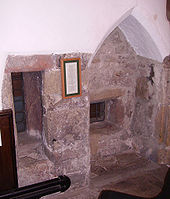Anchor

An anachoret (from ancient Greek ἀναχωρεῖν anachōreín "to withdraw, to move into the country (outside the fortified city)") was in ancient Greek usage a person who withdrew from the community, the chora, for personal reasons. Already in Hellenistic-Roman Egypt , anchorites were called in pre-Christian times. B. to withdraw from taxation or conscription, fled to the desert or inaccessible marshland in the Nile Delta. Later the term passed to the early Christian monks . The assignment of a monk to anchorage means nothing more than his withdrawal from society, who then either lives as a coinobit in monastic community with other anchorites or as a hermit can live secluded and withdrawn.
The earliest representative of the Christian anchorites is Saint Anthony the Great (also Antonius the Hermit) (251? –356). The first anchor communities, loose associations of more or less separated hermits, formed in his environment as a transition to Koinobitentum.
From the 5th century onwards, the pillar saints were an extreme form of the anchorites , the most famous of which, Saint Symeon , induced a large number of imitators in Syria to live their lives on a high pillar. Instead, dendrites retreated to a tree. Complete withdrawal from the environment was practiced by those anchorites who let themselves be walled into cells and were only given food through a small opening. One such archaeological site is Sayala in Nubia ; For the few cases in Egypt there are no excavation findings, but contemporary sources.
Monastery cells attached to churches are also known from medieval England , the entrance doors of which were walled up. The anchorites, designated as inclusions , were able to hear Holy Mass and receive communion through a small window that opened towards the altar of the church , while they could be supplied with essentials through an opening facing the street.
See also
Web links
Individual evidence
- ^ Peter Grossmann: Christian architecture in Egypt. (Handbook of Oriental Studies. Section One: The Near and Middle East. Volume 62) Brill, Leiden 2002, p. 258.